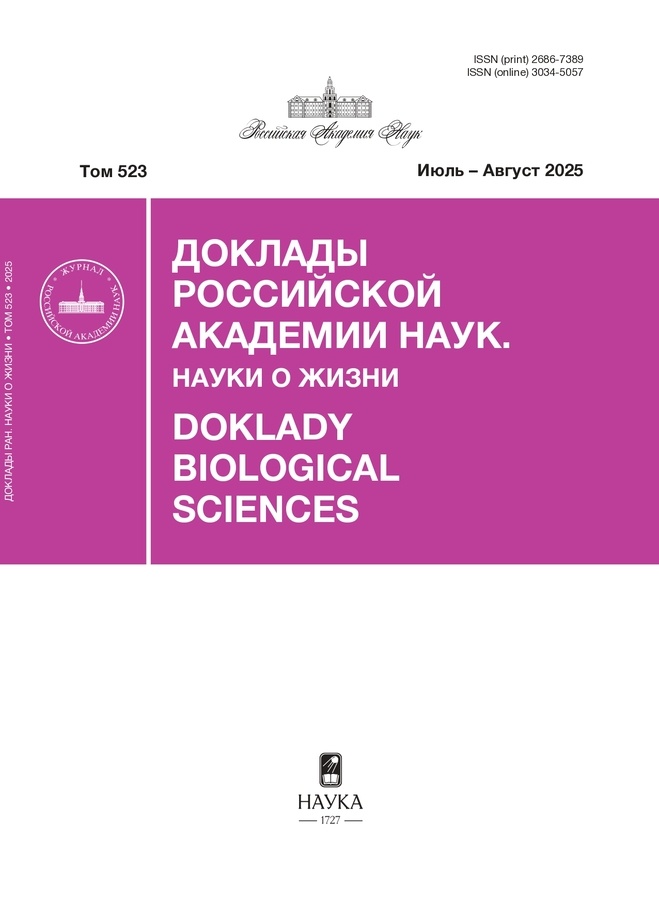Кардиорегенеративный потенциал иглистых мышей (Acomys cahirinus) манифестирует в делокализации пейсмекерного миокарда и преобладании неклассического пути холинергической регуляции ритмоводителя сердца
- Авторы: Кузьмин В.С.1,2, Егоров Ю.В.1, Кархов А.М.1,2, Болдырева М.А.1,3, Парфенова Е.В.1
-
Учреждения:
- ФГБУ национальный медицинский исследовательский центр кардиологии имени академика Е.И. Чазова Министерства здравоохранения Российской Федерации
- Московский государственный университет имени М.В. Ломоносова
- Национальный исследовательский университет “Высшая школа экономики”
- Выпуск: Том 520, № 1 (2025)
- Страницы: 151-158
- Раздел: Статьи
- URL: https://gynecology.orscience.ru/2686-7389/article/view/682069
- DOI: https://doi.org/10.31857/S2686738925010255
- EDN: https://elibrary.ru/svzzbl
- ID: 682069
Цитировать
Полный текст
Аннотация
Иглистые мыши (Acomys cahirinus) обладают способностью к восстановлению поврежденного миокарда и функциональных показателей сердца. Кардиорегенерацию у Acomys связывают с сохранением неонатальных свойств у ткани сердца взрослых животных. Электрофизиология и механизмы регуляции ритма сердца Acomys не исследованы. В работе регистрировали ЭКГ у иглистых мышей in vivo, оценивали и картировали биоэлектрическую активность в суправентрикулярном миокарде. Потенциалы действия пейсмекерного типа обнаруживаются в значительной части правого предсердия Acomys, а начальная активация охватывает 41% площади предсердия. Холинергическая стимуляция у Acomys приводит к крайне выраженному подавлению автоматии и изменению паттерна активации пейсмекерного миокарда. Холинергическое торможение автоматии у Acomys обусловлено IKAch-независимыми механизмами. Кардиорегенарвиный потенциал иглистых мышей манифестирует в особенностях функционирования и регуляции ритмоводителя сердца.
Полный текст
Об авторах
В. С. Кузьмин
ФГБУ национальный медицинский исследовательский центр кардиологии имени академика Е.И. Чазова Министерства здравоохранения Российской Федерации; Московский государственный университет имени М.В. Ломоносова
Автор, ответственный за переписку.
Email: ku290381@mail.ru
Кафедра физиологии человека и животных, биологический факультет, Московский государственный университет имени М.В. Ломоносова
Россия, Москва; МоскваЮ. В. Егоров
ФГБУ национальный медицинский исследовательский центр кардиологии имени академика Е.И. Чазова Министерства здравоохранения Российской Федерации
Email: ku290381@mail.ru
Россия, Москва
А. М. Кархов
ФГБУ национальный медицинский исследовательский центр кардиологии имени академика Е.И. Чазова Министерства здравоохранения Российской Федерации; Московский государственный университет имени М.В. Ломоносова
Email: ku290381@mail.ru
Кафедра физиологии человека и животных, биологический факультет, Московский государственный университет имени М.В. Ломоносова
Россия, Москва; МоскваМ. А. Болдырева
ФГБУ национальный медицинский исследовательский центр кардиологии имени академика Е.И. Чазова Министерства здравоохранения Российской Федерации; Национальный исследовательский университет “Высшая школа экономики”
Email: ku290381@mail.ru
Faculty of Biology and Biotechnology
Россия, Москва; МоскваЕ. В. Парфенова
ФГБУ национальный медицинский исследовательский центр кардиологии имени академика Е.И. Чазова Министерства здравоохранения Российской Федерации
Email: ku290381@mail.ru
член-корреспондент РАН
Россия, МоскваСписок литературы
- Gaire J., Varholick J., Rana S., et al. Spiny mouse (Acomys): an emerging research organism for regenerative medicine with applications beyond the skin // NPJ Regen Med. 2021. Vol. 6. N. 1. P. 1–16.
- Koopmans T., van Beijnum H., Roovers E., et al. Ischemic tolerance and cardiac repair in the spiny mouse (Acomys) // NPJ Regen Med. 2021. Vol. 6. N. 1. P. 78–98.
- Qi Y., Dasa O., Maden M., et al. Functional heart recovery in an adult mammal, the spiny mouse // Int J Cardiol. 2021. Vol. 1. N. 338. P. 196–203.
- Peng H., Shindo K., Donahue R., et al. Adult spiny mice (Acomys) exhibit endogenous cardiac recovery in response to myocardial infarction // NPJ Regen Med. 2021. Vol. 6. N 1. P. 74–84.
- Farraj A., Hazari M., Cascio W. The utility of the small rodent electrocardiogram in toxicology // Toxicological Sciences. 2011. Vol. 121, N 1. P. 11–30.
- Kuzmin, V., Malykhina, I., Pustovit, K., et al. Inflammatory degranulation of the cardiac resident mast cells suppresses the pacemaking and affects activation pattern in the sinoatrial node // Translational Research in Anatomy. 2022. Vol. 26. 100170.
- Kuzmin V., Abramov A., Egorov Y., et al. Hypothermia-induced postrepolarization refractoriness is the reason of the atrial myocardium tolerance to the bioelectrical activity disorders in the hibernating and active ground squirrel Citellus undulatus // Dokl Biol Sci. 2019. Vol. 486. N. 1. P. 63–68.
- Ivanova A., Samoilova D., Razumov A., et al. Rat caval vein myocardium undergoes changes in conduction characteristics during postnatal ontogenesis // Pflugers Arch. 2019 Vol. 471. N. 11–12. P. 1493–1503.
- Потехина В.М., Аверина О.А., Кузьмин В.С. Суправентрикулярный миокард сердца мышей B6CBAF1 проявляет генетически обусловленную аритмогенность благодаря эктопической автоматии и триггерной активности // Вестник Московского университета. Серия 16. Биология. 2019. T. 74. №2. С.115–122
- Kuzmin V., Potekhina V., Odnoshivkina Y., et al. Proarrhythmic atrial ectopy associated with heart sympathetic innervation dysfunctions is specific for murine B6CBAF1 hybrid strain // Life Sci. 2021 Feb 1; 266: 118887.
- Heier C., Hampton T., Wang D., et al. Development of electrocardiogram intervals during growth of FVB/N neonate mice // BMC Physiol. 2010. Vol. 10. N. 16.
- Tapilina S., Abramochkin D., Sukhova G., et al. Cholinergic inexcitability in the sinoatrial node of the mouse // Dokl Biol Sci. 2010. Vol. 435. P. 393–397.
- Wiese C., Grieskamp T., Airik R., et al. Formation of the sinus node head and differentiation of sinus node myocardium are independently regulated by Tbx18 and Tbx3 // Circ Res. 2009. Vol. 104. N. 3. P. 388–397.
- Anderson R., Brown N., Moorman A., Development and structures of the venous pole of the heart // Dev Dyn. 2006. Vol. 235. N. 1. P. 2–9.
- Tapilina S., Abramochkin D. Decrease in the Sensitivity of Myocardium to M3 Muscarinic Receptor Stimulation during Postnatal Ontogenisis // Acta Naturae. 2016. Vol. 8. N. 2. P. 127–31.
- Ivanova A., Tapilina S., Kuz’min V. Role of Muscarinic M1, M2, and M3 Receptors in the Regulation of Electrical Activity of Myocardial Tissue of Caval Veins during the Early Postnatal Ontogeny // Bull Exp Biol Med. 2019. Vol. 166. N. 4. P. 421–425.
- Bogdanov K., Maltsev V., Vinogradova T., et al. Membrane potential fluctuations resulting from submembrane Ca2+ releases in rabbit sinoatrial nodal cells impart an exponential phase to the late diastolic depolarization that controls their chronotropic state // Circ Res. 2006. Vol. 99. N. 9. P. 979–987.
- Alkass K., Panula J., Westman M., et al. No Evidence for Cardiomyocyte Number Expansion in Preadolescent Mice // Cell. 2015. Vol. 163, N. 4. P. 1026–1036.
- Adachi T., Shibata S., Okamoto Y., et al. The mechanism of increased postnatal heart rate and sinoatrial node pacemaker activity in mice // J Physiol Sci. 2013. Vol. 63. N. 2. P. 133–146.
- Ryvkin A., Furman A., Lebedeva E., et al. Analysis of changes in the action potential morphology of the mouse sinoatrial node true pacemaker cells during ontogenetic development in vitro and in silico // Dev Dyn. 2024. Vol. 253. N. 10. P. 895–905.
Дополнительные файлы










